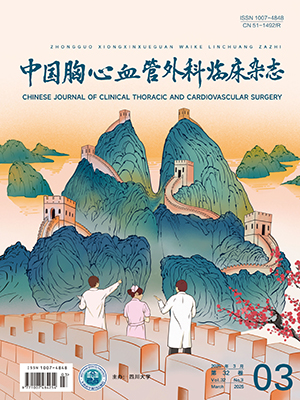Abstract: Objective To explore the surgical procedures and cerebral protection and improve surgical results by summarizing the experiences of surgical treatment of 68 patients of De Bakey Ⅰ aortic dissection. Methods We retrospectively analyzed the clinical data of 68 patients (including 45 males and 23 females aged 29 to 72 years with an age of 44.5±17.2 years) with De Bakey Ⅰ aortic dissection who were treated in the General Hospital of Shenyang Command between May 2004 and April 2010. Acute aortic dissection (occurring within 2 weeks) was present in 57 patients and chronic aortic dissection in 11. The intimal tear was located in the ascending aorta in 45 patients, in the aortic arch in 12 and in the descending part of the aortic arch in 11. Thirtyfive patients underwent emergency operation and 33 underwent selected or limited operation. The operations were performed under hypothermic circulation arrest plus selective antegrade cerebral perfusion or right vena cave retrograde cerebral perfusion to protect the brain. Total arch replacement and stented elephant trunk were performed in 25 patients, Bentall operation with concomitant total arch replacement and stented elephant trunk in 16 patients, pure right semi aortic arch replacement and stented elephant trunk in 15 patients, total aortic arch replacement in 7 patients, right semi aortic arch replacement and stented elephant trunk in 3 patients, and Cabrol operation with concomitant aortic conduit with valve and total arch replacement and stented elephant trunk in 2 patients. Results Five patients (4 with acute aortic dissection and 1 with chronic aortic dissection) died with an operative mortality of 7.4%(5/68). The causes of death were anastomotic bleeding during surgery in 1 patient, postoperative low cardiac output syndrome and malignant arrhythmia in 2, acute renal failure in 1 and cerebral complications in 1. During perioperative period, psychotic symptoms occurred in 5 patients, pericardial effusion in 2 patients, hoarseness in 6 patients and poor wound healing in 1 patient. All of them were cured before dehospitalization. Sixty patients (95.2%, 60/63) were followed up for 2 months to 6 years with the other 3 patients lost. During the ollow-up, sudden death occurred to 1 patient with unknown reasons, and 1 patient had pericardial effusion and symptoms improved with relevant treatment. All the other patients followed up had a good quality of life with significant improvement of heart function. Fiftyfour patients had a heart function of New York Heart Association class Ⅰ and 5 had a function of class Ⅱ. Conclusion The surgical treatment for De Bakey Ⅰ aortic dissection should be active. The beneficial results can be obtained with best choice of operative procedures, methods of cerebral protection, and adequate treatment of complications of operation.
Citation: TAO Dengshun,WANG Huishan,JIANG Hui,et al .. Surgical Treatment of De Bakey Aortic Dissection. Chinese Journal of Clinical Thoracic and Cardiovascular Surgery, 2011, 18(3): 218-221. doi: Copy
Copyright © the editorial department of Chinese Journal of Clinical Thoracic and Cardiovascular Surgery of West China Medical Publisher. All rights reserved




